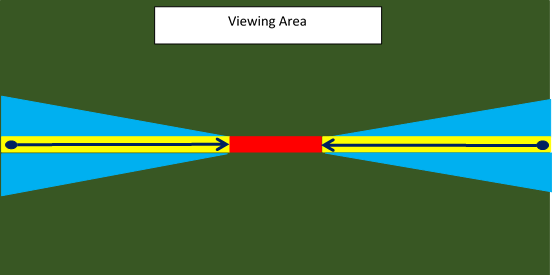By Dede Kilic, Aneala
To give archers a chance to test their skills in archery against individual combatants, the Anealans developed a series of combat archery tourneys. These provide varying challenges and allow an archer to show their skill to the best advantage.
All of these archery tourneys can be run as a round robin or with one of the other related tournament formats such as double elimination.
Field Layout
This one modifies The Joust and makes it more linear. Because most of the shooting occurs back and forth viewers can be positioned in safe areas on either of the long sides. Each archers run is 30 metres long and 2 metres wide. The red area is 8 metres, so that if the archer’s breast the line, then their bows will be no more than 80cms inside the red area which places potential shooting distance at 6.4m.
Combatants
2 archers at a time with 6 arrows each.
Scenario
The archers start at opposite ends of the field from each other. Each archer has six arrows and walks down their path firing their arrows. If both archers reach the middle from where they started, then they keep shooting until one runs out of arrows or is killed.
How to Win
The winner is the archer who is left standing. If both archers run out of arrows it is deemed a double kill and the bout will be refought.
Safe Viewing Areas
Assuming a safe distance of 15 metres and the front of the viewing area is kept to 20 metres. This makes them safe from any likelihood of an arrow reaching them. The arrow zones (light blue areas) were calculated by assuming the archer shooting an arrow is up against the barrier and their bow is over the line. It also assumes that their target is diagonally opposite also standing at the barrier. This should be the steepest angle the arrow is fired at during the tournament.
Variations
- That each archer be restricted to 3 arrows. This would make the archers husband their resources more rather than firing one off because they might get lucky.
- Narrow the width of each run to around 1.5 metres making it harder to dodge, so archers would have to think more about closing with their opponents.


